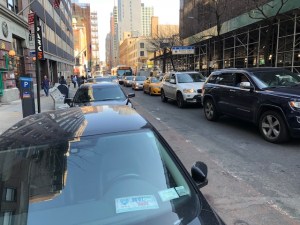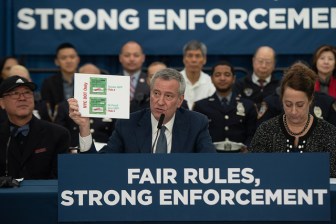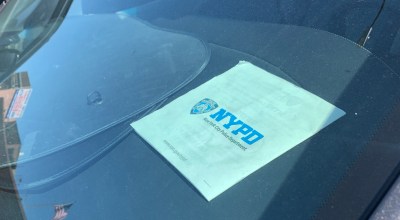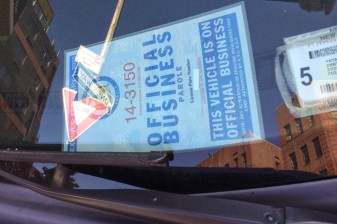NYPD Opposes Bill to Curb Placard Abuse as Total Soars to 118,000

At a City Council Transportation Committee hearing today, the New York Police Department announced its opposition to legislation that would curb parking placard abuse by requiring barcodes on official placards. NYPD claimed that it has placard abuse under control and that only Police Commissioner Ray Kelly should have the power to determine what tools are used to defend against it. Testimony from NYPD and DOT also revealed that there are currently 118,000 official placards in circulation, tens of thousands more than previously realized.
Putting barcodes on placards would allow traffic enforcement agents to easily and accurately know whether the laminated plastic sitting on a car’s dashboard legitimately grants extra parking privileges. That wouldn’t solve every kind of placard abuse, but it would empower agents to ticket the truly bogus placards.
Council Member Dan Garodnick, the bill’s sponsor, cited yesterday’s experiment by Transportation Alternatives, in which a placard from the “New York State Numismatic Agency,” marked with the official seal of Bulgaria, escaped ticketing during seven hours of illegal parking in Lower Manhattan, Downtown Brooklyn and Times Square, proving that placard enforcement was effectively non-existent. “It’s clearly time for the city to take a bolder step,” said Garodnick.
Council members from across the city understood that allowing placard holders to hoard curb space and escape parking regulations is hurting their neighborhoods. “It seems like New York City has become the Wild West of parking permits,” said Brooklyn’s David Greenfield. Said Queens rep Jimmy Van Bramer, “Others, particularly those who work for a city agency, are held to a different standard.”
The only person who didn’t see the need for action on placard abuse was Susan Petito, the assistant commissioner for intergovernmental affairs at NYPD. While Petito gave lip service to the council’s concern, she ultimately claimed that the NYPD had the problem under control.
When Garodnick asked Petito whether the placards currently issued by the NYPD are “secure and free from fraud today,” Petito said they were: “The actual placards have security features that we think are very robust.”
Garodnick then pointed out the obvious: “Does it really matter how great your security features are if an agent looks at your perfectly secure placard and looks at a photocopied bogus placard and can’t tell the difference?”
Petito and DOT Deputy Commissioner David Woloch revealed that there are currently far more official placards in circulation than previously announced. In its April report on placard abuse, Transportation Alternatives cited 78,000 as the official placard total. But between NYPD and DOT-issued placards, the total has crept back up to 118,000, Petito and Woloch testified. Much of the progress made by the Bloomberg administration to reduce the number of placards has been eroded.
Petito also put forward a constantly shifting set of rationales rejecting the addition of barcodes to parking placards. First she claimed that NYPD’s equipment couldn’t scan though the windshield onto the dashboard. When Van Bramer suggested turning placards into stickers, Petito moved on to suggesting that the scanners didn’t have enough memory to store the database of barcodes.
As the discussion progressed, Petito would not describe what system NYPD believes would effectively allow traffic agents to determine the validity of a placard, claiming that explaining the current features in public would compromise their security. NYPD wouldn’t object to legislation that allowed the police commissioner to determine what security features he felt were necessary — the status quo, in other words.
Several times, Petito displayed a failure to understand the basic intent of Garodnick’s legislation. When she argued that there wouldn’t be a barcode on the fake Numismatic Agency placard anyway, Garodnick tried to explain that was the point. “We do not issue placards to them,” Petito still maintained.
Petito’s explanation of current placard enforcement revealed the NYPD’s lack of commitment to solving the placard abuse problem. In response to a question by Council Member Peter Koo about what an ordinary traffic enforcement agent is supposed to when he sees a placard, Petito told him,”They will look at a permit and if it looks legitimate, they will not issue the ticket,” unless the car is parked at a hydrant or some other location where even placards do not allow one to park. “If it looks like a fraudulent placard,” she continued, “then they will notify the Internal Affairs Bureau for further investigation of that placard.”
When I spoke to James Huntley, the president of the traffic enforcement agents’ union, he said his members do indeed give out parking tickets to cars with obviously fake placards and only call in Internal Affairs for cases where the placard seems to be a fraudulent reproduction or imitation of an official NYPD placard. If Huntley is right, it would be another indication that Petito did not understand that placard abuse goes far beyond the abuse of official placards.
The special placard division of Internal Affairs has issued 29,885 summons and towed 6,484 cars using improper placards, in addition to roughly 100 more serious actions, since April 2008, said Petito. With a dozen officers working in the placard division, that only works out to about two and a half placard abusers caught by each Internal Affairs officer each day. In contrast, Transportation Alternatives volunteers found 330 fake or illegally-used placards in just one day in Downtown Brooklyn last January.
In public testimony, many argued for more sweeping changes. “It is the fault of a broken placard system,” said Transportation Alternatives general counsel Juan Martinez. So long as a laminated piece of paper is enough to have free access to valuable parking spaces, he said, “You’re inviting abuse. You’re inviting fraud.”
Jonathan Kalkin, who has served as the chair of the Roosevelt Island Operating Corporation Operations Committee, suggested that the city “make citizens able to scan, get that information and then upload it as a complaint to 311.” Combining some sort of technological solution with crowdsourcing would “stop police officers from worrying about protecting their own,” he argued.
Six other parking bills were up for discussion at the hearing, all of which made it easier to park or to pay or contest a parking ticket. The most far-reaching was sponsored by Transportation Committee Chair James Vacca. His legislation would require that traffic enforcement agents affix photographs to parking tickets for certain violations as additional evidence. NYPD opposed the bill on the grounds that it would imply that the sworn statement of the agent is not good enough to find someone guilty of a parking violation.



